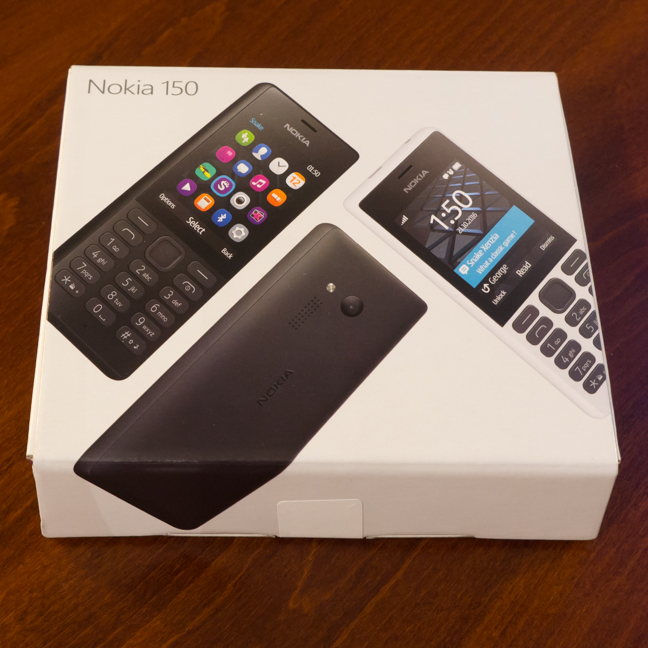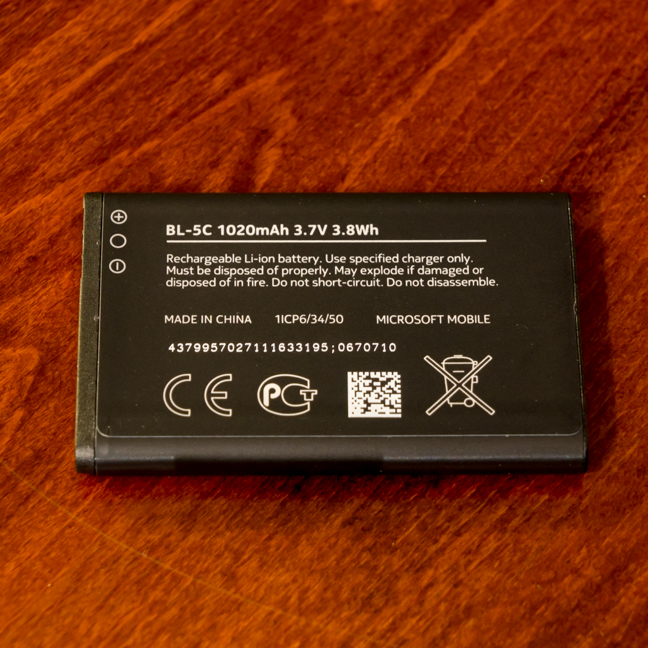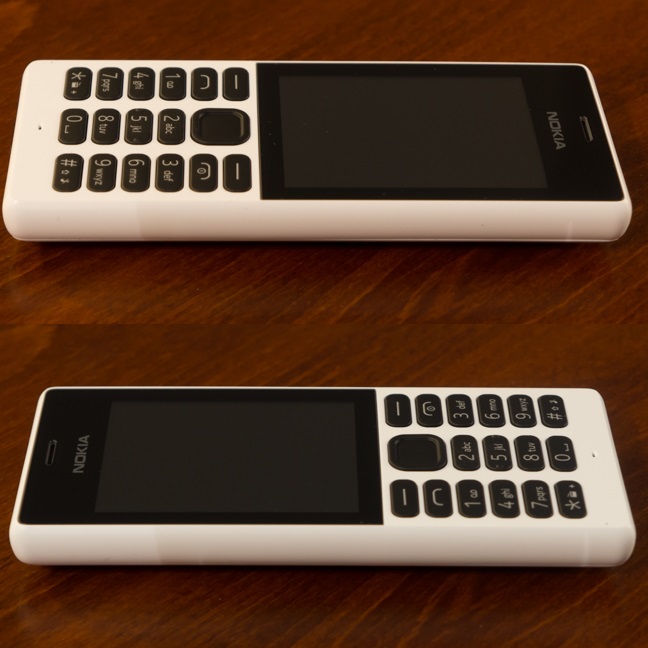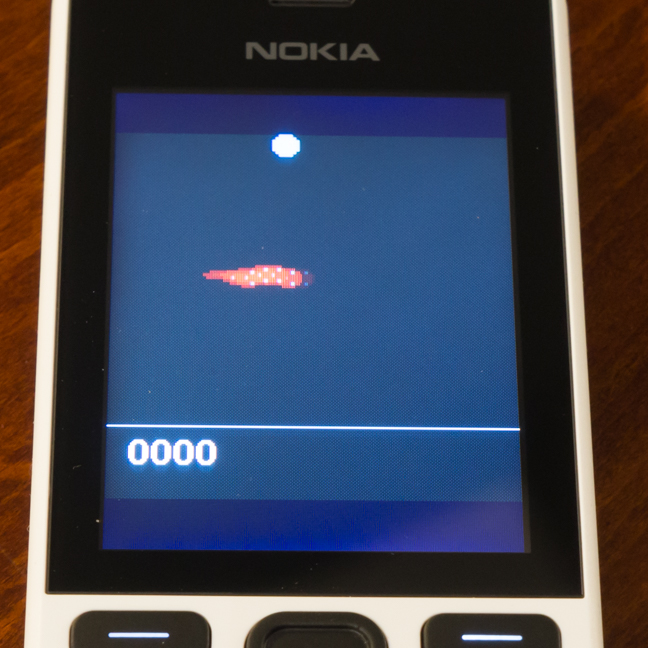
Ah, Nokia. The brand that connected so many people back in the nineties. The brand that soared so high in the mobile communications market, only to dip to unimaginable lows in the last few years. Under the new ownership of Foxconn and HMD global, the iconic brand has resumed its production of feature phones, the ancestors of current mobile devices. Since many of you are interested in seeing where this new road will take the Finnish company, we decided to take a break from our usual reviews of high-tech equipment and boldly go where few have gone before: we tested the Nokia 150, a fresh-looking feature phone which retails for less than USD 30. Let's see what this baby can do, shall we?
Packaging, design and build quality of the Nokia 150
Before we go any further, let's answer a simple question: what on Earth is a "feature phone"? Plain and painfully simple, it is the exact opposite of what its name suggests: a phone with no features whatsoever. It's the phone that your tech-hopeless relatives use. The phone that hipsters buy to feel vintage. It's the one item that's left behind after someone breaks into your car. And yet, it's the phone that has the potential to outlast every other electronic device in existence, both regarding battery and overall endurance. Now that we got this out of the way and after setting your expectations at ground level, let's resume our usual review procedure:
The phone comes in a white box, with photos of the phone from different angles on the front cover.
The box contains the phone (in white, on our test sample), the battery, the micro USB charger and the manual. Sadly, no headset was included in the package we received. But, depending on where you live, you might find one included.
Well? What would you expect from a phone that costs less than 30 bucks? A wireless charger? The phone doesn't even have WiFi capabilities, but we'll get to that in a minute.
The 550mA rated charger is small, both in output and size and, in the Nokia tradition, the cable is non-removable from the charger unit. Before getting the pitchforks, remember though that this is a "feature phone," so even the fact that the charging port is in micro-USB format is shocking.
The phone comes in two colors, dull black and extremely white. Yes, I made up those names, but you must admit they sound real.The case is made of polycarbonate, and it keeps its color even when scratched, which is a good thing, considering the range of users for this small phone.
Just how small, you ask? It's 4.65 inches (118 mm) tall, 1.97 inches (50.2 mm) wide and 0.53 inches (13.5 mm) thick. Quick riddle: what's white, sleek, durable and weighs 3.99 ounces? Wrong, the answer is the iPhoneSE, which we previously reviewed and simultaneously fell in love with. Coming back to our feature phone, it only weighs 2.85 ounces or 81 grams with the removable battery included (take that, iPhone), so it's reasonably light. The phone feels even smaller due to its rounded corners and, combined with the texture of the case, makes for a very slippery piece of ancient tech.
Coming from a smartphone, you will find that the front of the phone has these weird things below the screen, and a quick Internet search will tell you they're called "buttons" or "keys." The keypad lights up when used (I know, mind-blowing) and the buttons are reasonably easy to press. The button in the middle acts like a joystick, but there is no chance you'll be able to use it properly unless you have tiny hands (trying hard not to insert a Donald Trump joke here).
The 2.4-inch screen is the dominant feature on the front of the phone. Other than the Nokia logo, the speaker grille, and the microphone, you won't find other features on the front of the Nokia 150 (my selfie addiction suffers greatly, but it's all in the name of science). Of course, you should not expect exotic features like a light and proximity sensor or even this highly advanced feature named "notification LED." Where do you think you are? In the 21st century?
The bottom and sides of the phone are as white as the feature sheet, with no volume rockers or any other items to disturb the sleek design of the phone.
The top of the phone houses the micro-USB charging port and the headphone jack, while the back of the phone houses the loudspeaker grille, the VGA camera, and a flash.
Before moving on to the next chapter, I will just add the fact that the back cover is removable, as is the battery. After removing both you'll be able to access both the SIM card slot (mini SIM size, not micro or nano SIM) and the microSD card slot. Okay, fine, you can add the microSD card slot as a feature.
The phone design is clean, simple and might even be considered appealing by some. The polycarbonate case feels okay to the touch, albeit being slippery. Some keys are too small and too close to one another for the average user, but with practice and fingernails, you'll be able to type correctly the number you want to call. Most of the time.
Hardware specifications and software interface of the Nokia 150
The Nokia 150 has two versions, a single-SIM, and a dual-SIM one. We reviewed the single SIM version, which boasts a slightly longer battery life. Now, I don't know what your definition of "long-lasting battery" is, but if you only have smartphone experience, you might consider that three days is excellent battery life. Comparing that to the battery life of the Nokia 150 might bring about a revelation: the declared battery life of the single-SIM Nokia 150 is 31 days. Yes, a full month. The dual-SIM variant has a claimed battery life of "only" 25 days. We'll test this in the next chapter, but even if it's half that, it qualifies the Nokia 150 as an excellent backup phone.
Of course, we can't talk about processor speeds and the number of cores, since Nokia feature phones are traditionally powered by little Finnish gremlins. What we can tell you, though, is that the Nokia 150 has no internal memory reserved for media files, so if you want to take pictures or listen to MP3 files, you need to equip the phone with a microSD card (up to 32 GB supported).
The screen is a mind-boggling 2.4-inch QVGA screen. You read it right, QVGA, which means 240 by 320 pixels. Even the display on my printer has more pixels than that! Since the screen is rather small, the 166 dots per inch pixel density is comparable to the iPhone. No, I don't mean the iPhone SE, I mean the original iPhone, released in 2007. Shockingly enough, the screen of the Nokia 150 is capable of rendering colors, albeit only 65.000 (compared to 16 million or more that displays from this century can render).
The back camera has a resolution of 640 by 480 pixels. With 0.3 megapixels, the only use I can think of for the photos taken by the Nokia 150 is a framed picture of an ant's living room. Yes, I'm a bit harsh on a phone that costs less than a haircut, but this is just the beginning, I promise I'll do better in the next chapter. Again, considering the specs, there is no point talking about focal length or variable focus, but at least it has a flash, which doubles as a flashlight. Yay! The camera can record videos at 144 by 176 pixels and 12 frames per second, which can then be successfully used as thumbnail videos and not much else.
And here, among the plethora of features that the Nokia 150 spoils us with, comes one of the issues that I consider as being a dealbreaker: the phone can only connect to dual-band 2.5G (900/1800 MHz) networks. You might say "but why would it need 3G or more if it has no access to the Internet?" Well, it's because some GSM service providers have upgraded their infrastructure to 3G and don't have 2G coverage anymore. This is a big issue, since it might render the phone almost useless in some areas of the world. As far as connectivity goes, the device has a Bluetooth 3.0 adapter and can also be accessed with a USB cable.
The battery is a removable Li-Ion 1020 mAh battery. For those of you who had Nokia phones in the past, it's the same old BL-5C battery, which is used in a variety of Nokia feature phones. It is capable of keeping the phone powered for a full month on standby or 22h when used for conversations.
Moving on to the software environment, the Nokia 150 uses the "Nokia Series 30+" platform, and after using the phone for about two weeks, I suspect the "30+" comes from the age of the software. In years. The software is instantly familiar to anyone who ever used a Nokia feature phone, and provides basic functions, such as Call log, Contacts, Alarm Clock, Calendar, Messaging, and Calculator. It also has multimedia functions, like FM Radio (available only when a headset is connected), MP3 player, camera and photo gallery, as well as a video player and "Snake Xenzia," a poor rendition of the Snake game from the old Nokias.
Keeping in mind its primary purposes, that of a backup phone and/or a phone for people who can't or won't handle a smartphone, the software does what it should do: it provides basic capabilities without any glitches or lag. Except for the Snake game, but we'll cover that in the next chapter.
The phone has limited capabilities and functions, as is the tradition for feature phones. Battery life is excellent, and the software is bug-free (maybe because it's so simple that no bugs can fit in the code). The only major issue is that the device is not 3G capable and it will be useless for some potential buyers.
Real-life performance of the Nokia 150
If you are a regular Digital Citizen reader, you will notice the absence of a Benchmarks section, and the reason is obvious. The only performance tests that can be done on the Nokia 150 are "how far can one get from civilization before one needs to recharge it" and "how many pictures taken with the Nokia 150 can one store on a 512MB card" (the answer to the last one is over 9000). Seeing how I could not devise another non-destructive test for this tiny apparatus, I simply began to use it.
The first few minutes with the Nokia 150 were kind of comical: I was going again and again through all the menu items, trying to find any trace of an internet connection: a browser, a messenger, an app store, ANYTHING! My mother uses a Nokia 100, so I was pretty familiar with the controls (since adding numbers to the Phone Book is too complicated for her). Actually, back in the days I owned one of these, but they were simpy called "mobile phones," and Missy Elliott was still a thing. Also, the Internet on cell phones was pretty much science fiction back then.
First thing of note: the menu of the Nokia 150 is painfully simple. It has a total of 16 icons, all visible once you press the Menu button. The menu structure is instantly recognizable for someone who hasn't been living in a cave for the past 20 years. All the features of the phone are easily accessible through the dedicated shortcuts on the central joystick. Well, relatively easy, not that much if you have big fingers since the buttons are fairly small and cramped.
After swapping the test SIM card with one from a different provider (as the one I was using had only 3G coverage), I tested the call quality indoors. Apart from being a bit on the quiet side, the speaker of the Nokia 150 had no audible defects.
As any good reviewer would, I tested the Nokia 150 in all kinds of situations, including using it in public. While walking down a relatively busy street, with constant traffic, I found that the volume of the speaker at maximum is not enough to cover the noise.
On the other hand, if you connect a set of headphones, the sound is loud and clear, although the sound quality is only average for music. As mentioned earlier, the phone has an FM receiver, so I listened to my favorite local radio station while I was on my bike, with very few reception issues.
I also tested the video and photo capabilities, which, as you can see, appear to come from a different century. The photos lack detail; the videos are minuscule and unusable on larger screens. Here you have an example (in the original size!) of a picture taken with the Nokia 150.
In low light, the quality degrades even more, as you can see below:
You can also take a look here at the other pictures we took with this phone, in the gallery below.
Next, I shot a video indoors, which you can see below:
There's also a video featuring moving subjects, so that you get an idea about this phone's video recording capabilities. Modest is an understatement. 🙂
Talking about screens, the Nokia 150 screen is bright and the low pixel density is not a problem for the regular user. Of course, coming from a smartphone, the screen looks archaic, but the fonts used and the amount of information displayed help the legibility quite a lot.
The battery life is close to the declared values: I charged it at the beginning of the testing session, and by the end of it, the battery was at roughly 50%. Extrapolating, this translates into 20 to 30 days of battery life on standby, which is a lot even by feature phone standards. You can forget where you placed the charger (especially of you're getting old and forgetful, like me).
The case proved to be well made, but it did get scratched after a few days of sharing a pocket with my apartment keys.
Overall, there was also a difference in attitude on my part towards the device. Whereas before, with the smartphone, I was careful not to drop it, not to scratch it or subject it to extreme temperatures, with the Nokia 150 I started to be more "relaxed." It became less of a gadget and more of a tool.
What I find unacceptable though is the fact that the Snake game was close to unplayable, due to the lag between the user input and the movements of the snake. How can one relax and play such an awesome game with this input delay? Unacceptable!
Oh, I forgot the part where I lost the chance to meet my soulmate during the review of this phone. She was gorgeous; she was walking down the street, I was staring in her eyes, she was staring at the Nokia 150 that I was using to take some pictures. She walked by, never to be seen again, and frankly, who could blame her? I mean, would you be interested in a dorky-looking guy trying to record a video of the traffic with a "feature phone"?
Pros and cons of the Nokia 150
Summarizing our findings, I liked the following:
- Excellent price
- Decent design for a feature phone and robust build quality
- Diminutive in size
- Excellent battery life
- Very easy to learn and use
However, there were also some things that I didn't like:
- THE SNAKE XENZIA GAME LAGS!
- The speaker is not powerful enough for outdoor use
- Not usable in 3G cellular networks
- Photos and videos taken with the Nokia 150 are like my love life: blurry and with low fidelity. 🙂
Verdict
The Nokia 150 is an average feature phone. I enjoyed the presence of a MicroSD card slot, the battery life and the simplicity and ease of use. Considering the small price tag and the 25+ days of battery life on standby, the phone is excellent as a backup phone. I always have a spare phone in my car, in a case of emergency. However, the small size and the weak speaker make the Nokia 150 unsuitable for elderly people or usage in noisy environments. The fact that it only supports 2G makes it even less appealing. If a comeback of feature phones is imminent, the Nokia 150 is certainly not its herald.


 13.04.2017
13.04.2017 













